Introduction
Stormwater runoff is rainfall that flows over the ground and is not absorbed by the soil or evaporated. Rainfall will often encounter impervious or pervious-resistant surfaces such as streets, parking lots, sidewalks, gravel roads or lots, rooftops, and other developed areas. These human-made surfaces will divert the natural flow of rainwater and direct the runoff into storm drains, retention ponds, ditches, or perhaps even the closest body of water. Any contaminants picked up from the impervious surfaces by stormwater runoff mobilize during this process—transporting fertilizer, oil, pet waste, heavy metals, soaps, and other potential pollutants from the environment into receiving waters.
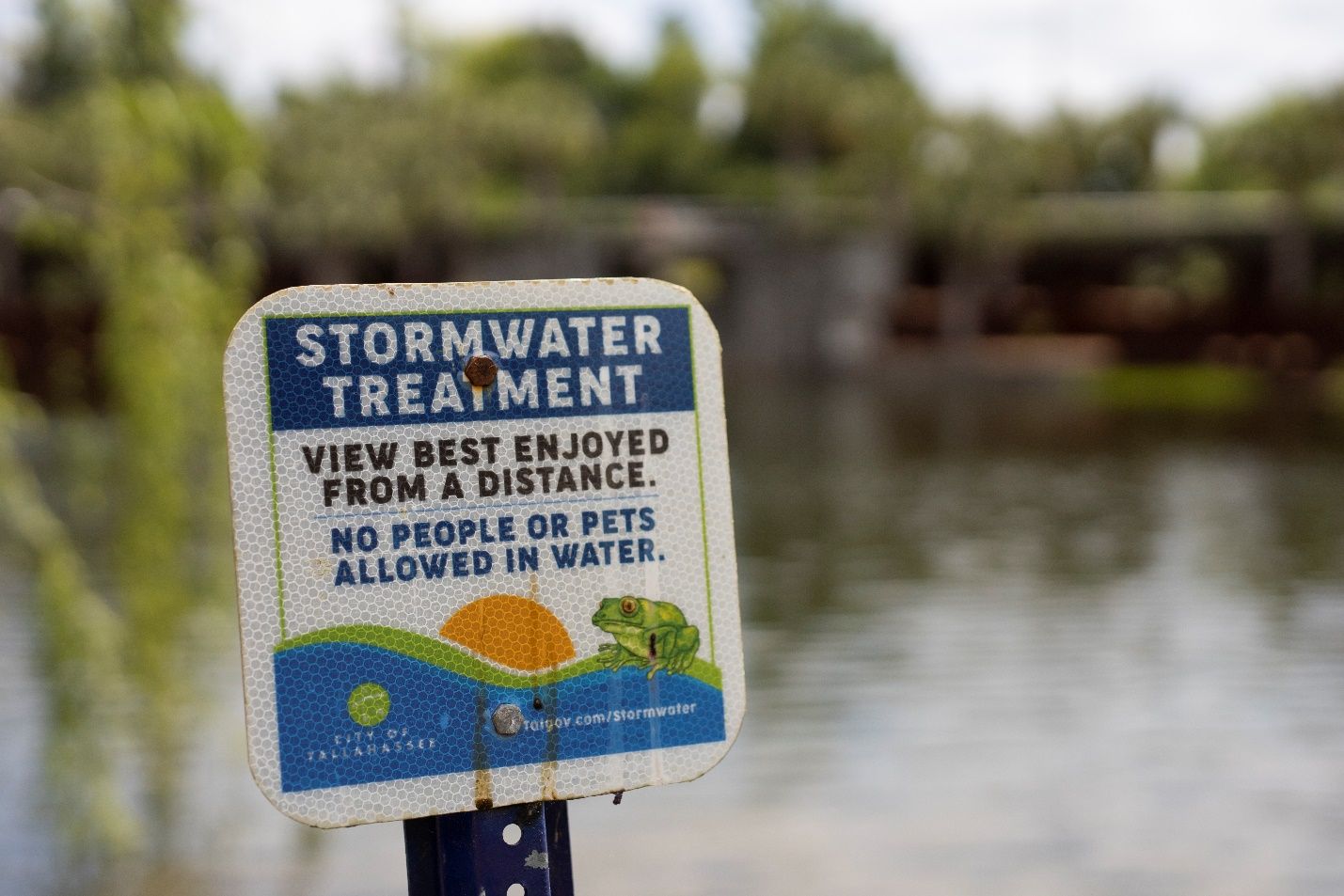
Credit: Tyler Jones, UF/ IFAS
This publication explains what happens when stormwater runoff enters constructed environments, its impacts on water bodies (i.e., surface waters such as lakes, rivers, and bays), and the steps individuals can take to reduce their own stormwater runoff footprint. This guide can increase awareness of ways to reduce each person’s role in water quality impairment by stormwater pollution. This publication is intended primarily for urban residential readers and does not focus on agricultural runoff.
Common Stormwater Runoff Pollutants
Stormwater runoff can mobilize a variety of pollutants as it makes its way through urban environments. Impervious surfaces such as roads, sidewalks, and parking lots can accumulate pollutants such as fertilizers, soaps and detergents, and oil and chemicals from vehicles or industrial processes. When it rains, stormwater picks up and transports these pollutants, carrying them into nearby waterways where they can have harmful effects on the environment and human health. As urbanization continues to increase, the impacts of stormwater pollution on water quality and ecosystems become increasingly significant. Table 1 outlines some common environmental pollutants picked up by stormwater.
Table 1. Common urban runoff pollutants and their sources.
The Problem with Stormwater Runoff
Stormwater runoff is a nonpoint source of pollution that contributes to water quality impairment (i.e., compromised water quality) in many water bodies. Nonpoint source pollution refers to pollution that comes from a scattered or non-specific source, such as runoff from multiple farms, parking lots, residential neighborhoods, and construction sites. Unlike point sources from specific places, such as wastewater treatment plants, stormwater runoff is considered a nonpoint source of pollution because it cannot typically be pointed back to one specific place of origin. That makes stormwater runoff challenging to manage and control.
The pollutants carried by stormwater runoff can have a range of harmful effects on water quality and aquatic life. Nutrients such as nitrogen and phosphorus, which are often found in fertilizers and animal waste, can lead to eutrophication (Yang and Lusk 2018), an excess of nutrients that can lead to excessive algal growth and oxygen depletion in water bodies. For example, the harmful algal blooms that often impair Florida’s coastal waters have been associated with excess nitrogen from stormwater runoff (Heil and Muni-Morgan 2021).
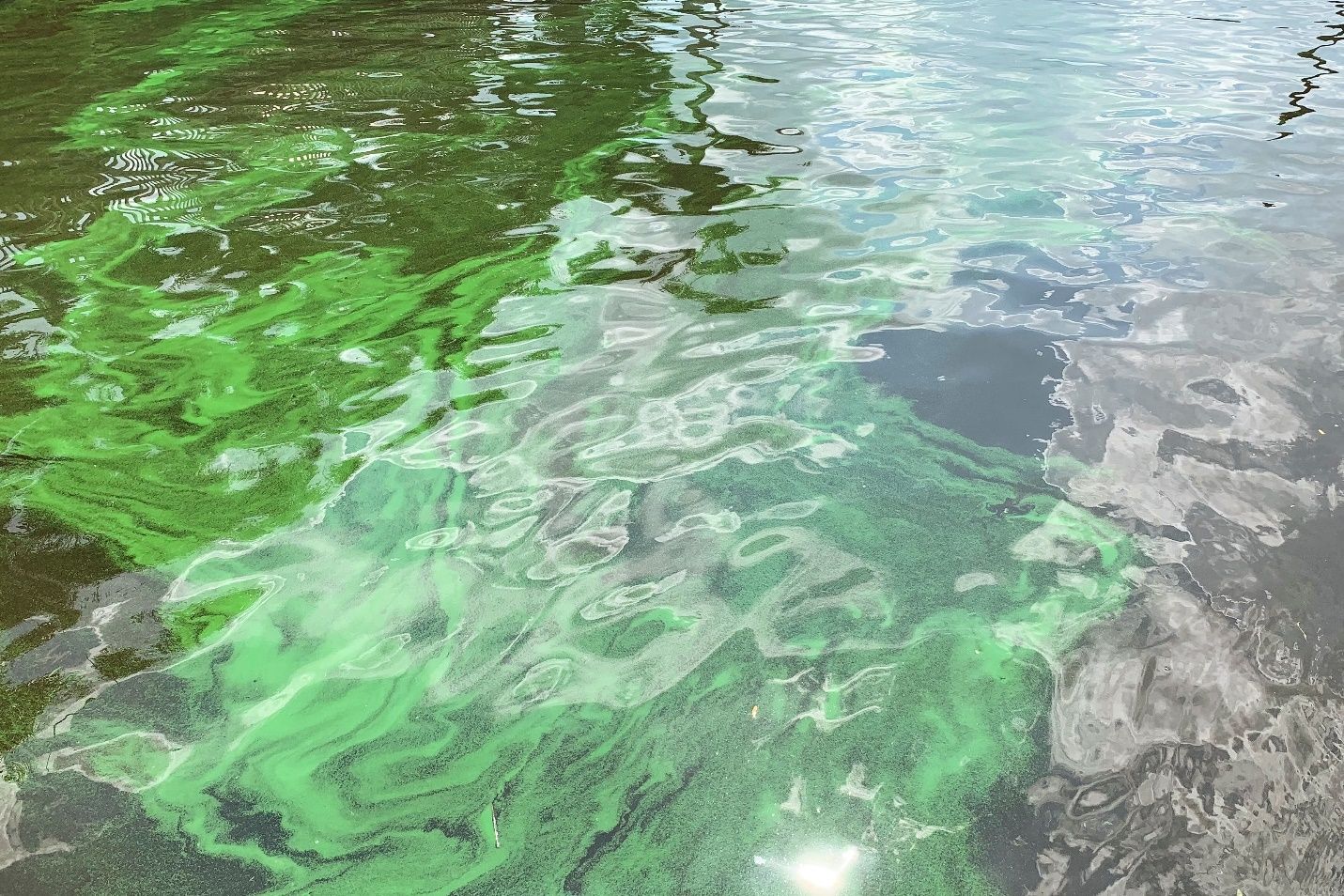
Credit: Dail Laughingho, UF/ IFAS
Heavy metals such as lead, cadmium, and mercury can cause long-term damage to aquatic ecosystems by contaminating sediments and entering the food chain. Bacteria in stormwater can be harmful if they are carried to a receiving water body used for recreational swimming, where people may be exposed to the bacteria. Microplastics, which are extremely small plastic particles, can harm aquatic organisms and accumulate in the food chain, leading to long-term impacts on human health. In addition, sediment and debris carried by stormwater runoff can reduce water clarity, which can harm aquatic plants and animals by limiting the amount of light that reaches them. Thus, it is crucial to implement effective stormwater management strategies to reduce the amount of pollution entering water bodies and to protect the health of our ecosystems and communities. Below are several actions that homeowners and the general public can take to reduce the impact of stormwater runoff in urban areas.
Water Management goes a Long Way
Because water mobilizes urban pollutants and carries them to nearby water bodies, water management is one of the best forms of stormwater pollutant management. This means that simply reducing the generated volume of stormwater runoff, from the beginning, will in turn reduce the impacts of stormwater runoff. Homeowners can reduce the volume of stormwater in their communities by introducing opportunities for rainfall to infiltrate the ground. You can do this by planting rain gardens on your property and keeping soils covered with vegetation. This will promote good water infiltration by preventing soil compaction. Learn about planning and planting a rain garden here: https://gardeningsolutions.ifas.ufl.edu/design/types-of-gardens/rain-gardens/.
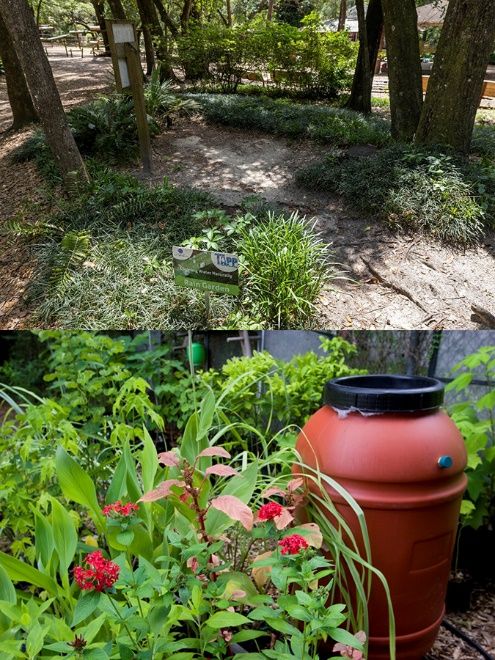
Credit: Cat Wofford (top), Tyler Jones (bottom); UF/ IFAS
Also, roof downspouts should be diverted to pervious surfaces. Often, downspouts are turned to drain onto driveways, where excess water then flows to the stormwater network. By instead diverting your downspouts to pervious surfaces, you allow that excess water to infiltrate the soil and reduce the overall volume of stormwater flow in your neighborhood.
Finally, reclaimed water used to irrigate lawns likely contains nitrogen and phosphorus in excess compared to potable water (Toor and Lusk 2011). If sprinkler systems are not maintained to only water vegetated surfaces, then some irrigation-driven runoff may occur on impervious surfaces. Thus, irrigation systems should be checked regularly to make sure only grass and plants are being watered and not the streets and sidewalks (Lusk and Rainey 2021).
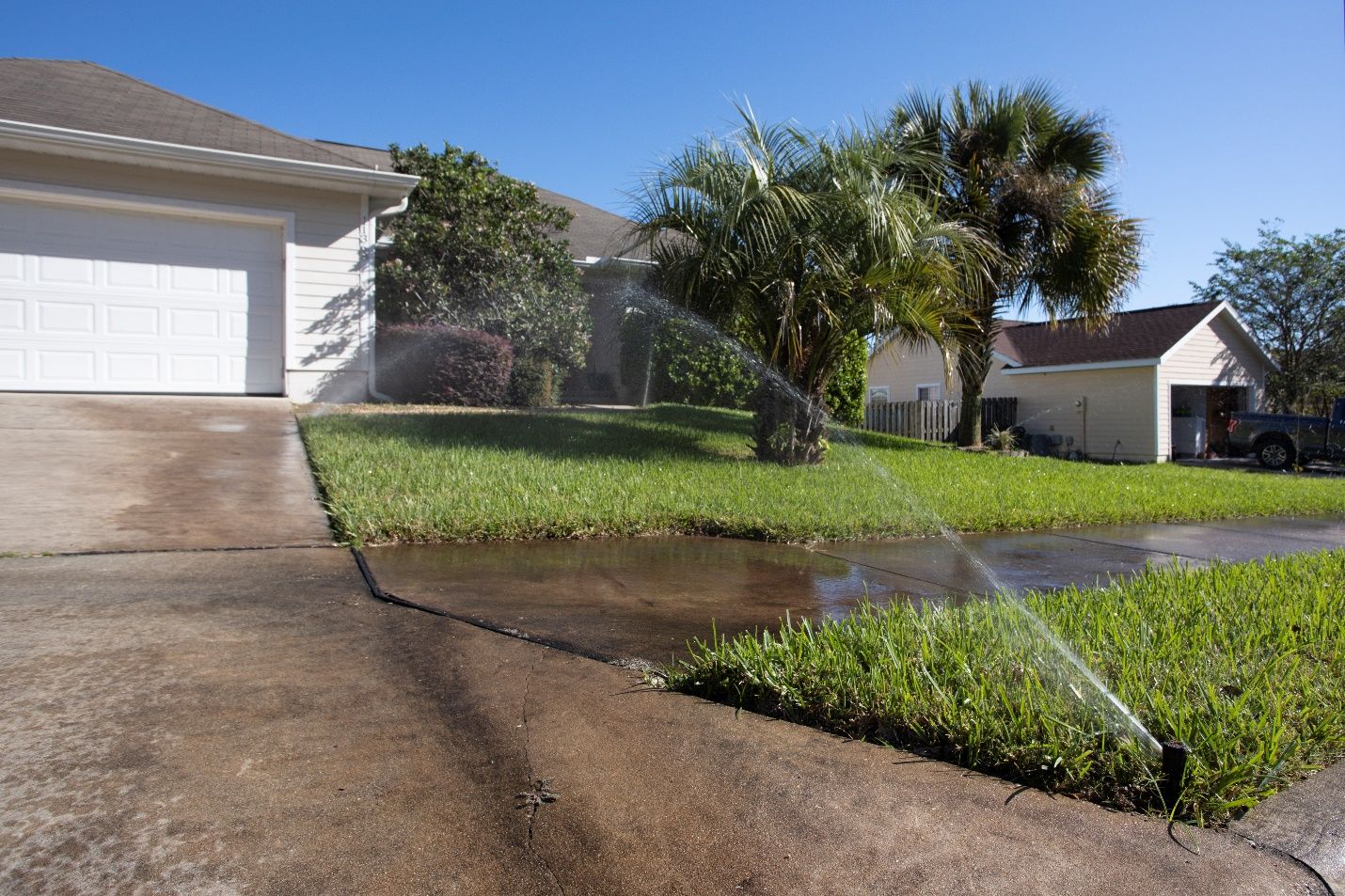
Credit: Tyler Jones, UF/ IFAS
Addressing Impacts from Fertilizers and Yard and Pet Waste
Fertilizers and yard and pet waste are common sources of nutrients, bacteria, and sediments in stormwater runoff from urban areas (Krimsky et al. 2021; Jani et al. 2020). Urban soils are often compacted and have poor drainage, making them a major contributor to increased stormwater runoff in urban areas. The process of urbanization can lead to the compaction of soils, as heavy construction equipment and increased foot and vehicle traffic can cause soil particles to become tightly packed, reducing the ability of the soil to absorb water. As a result, rainwater can quickly accumulate on the surface, leading to increased runoff and the potential for flooding. Additionally, urban soils in Florida are often sandy with low organic matter, making it difficult for them to retain moisture and nutrients, which can impact plant growth and soil health. To compensate for this, fertilizer inputs may be necessary to maintain healthy plants and vegetation.
Residential fertilizers can be managed through the 4 “Rights” (aka 4 Rs), which are 4 general areas of influence (Right Source, Right Rate, Right Time, and Right Place) involved in fertilizer management, with specific actions detailed in Table 2.
Table 2. The 4 “Rights” of fertilizer management.
Urban residents typically have property maintenance that occurs regularly, and even more so in Florida with a year-round, sub-tropical climate in most of the state. This upkeep leads to accumulated yard waste (e.g., grass clippings, leaf litter, and trimmings/deadfall from trees, bushes, and shrubbery) within the property. Like other forms of organic matter, yard waste will break down into the basic elements that form the makeup of plant life, specifically the macronutrients nitrogen and phosphorus (Lusk, Toor, and Inglett 2020).
Nutrient loads refer to the amount of nutrients entering a water body at any time. To minimize the accumulation of mobile nutrient loads from yard waste, prevent grass clippings from leaving the permeable surface of the lawn. An example of this would be using mulching blades on the lawn mower which deposit the broken-up grass clippings onto the lawn. Alternatively, materials like grass clippings and leaves can be collected and composted. They should always be kept out of community storm drains, swales, and stormwater ponds.
Pet waste contains bacteria, as well as nitrogen and phosphorus, and have been identified as one potential source of excess nutrients in stormwater runoff in Florida’s coastal areas (Krimsky et al. 2021). Pet waste should be collected and disposed of in a pet waste disposal bin or the municipal garbage. Pet waste should not be added to compost materials if the compost will be used for gardens or will make contact with food crops, since the pet waste may contain harmful bacteria.
Addressing Secondary Inputs: Soaps, Detergents, and Automobile Fluids
Soaps and detergents in stormwater runoff can impair receiving waters through the addition of ammonia, phenols, acids, and antibiotics. Detergents used in some car wash cleaners have significant effects on aquatic life due to the key ingredient surfactants, also known as surface active agents. These will influence a water body by killing fish eggs, damaging fish gills, and reducing the fish’s ability to protect itself from parasitic and bacterial threats.
The use of car cleaners that are phosphate-free, water-based, and biodegradable is an immediate step to reduce the individual footprint from soap and detergent run-off; although, these products are not so easily found at local markets. Phosphate-free alternatives will not contribute to the nutrient loading of water that can occur when stormwater mobilizes phosphate from phosphate-based detergents. Additional steps are to minimize the volume of water used when washing the vehicle by using a bucket of water or a flow-regulating hose spray head and to wash on areas that are more permeable than a driveway, street, or paved area.
Wash-water containing phosphate and/or non-biodegradable cleaners should not be allowed to soak into the ground at all, if possible. Washing the automobile on gravel or grass gives the water an opportunity to be filtered before it can arrive at a storm drain, surface water body, or groundwater source. If washing on a paved surface is unavoidable, then locate any areas that allow the flow of gravity and the slope of the terrain to drain the water towards vegetated parts of the lawn.
Additionally, whenever emptying the wash buckets, whether filled with conventional soap/detergent or the biodegradable, water-based, and phosphate-free variety, always dispose of them in the sinks or toilets of your home instead of down storm drains or in the landscape.
To reduce the amount of automotive fluid mobilized by stormwater runoff, an effective strategy is addressing oil leaks in vehicles and identifying the proper channels to dispose of oil and other automobile related pollutants. The Florida Department of Environmental Protection (FDEP) has a resource to help identify the nearest center for oil collection through their public, used oil collection center search.
Addressing the Emerging Contaminant of Concern: Microplastics
Microplastics are becoming more recognized as an emerging contaminant of concern. Since nylon and polypropylene are used in many consumer products, it is virtually impossible for the average consumer to have not contributed to this input category. Microplastics are defined by the U.S. National Oceanic and Atmospheric Administration (NOAA) as fragments of plastic less than 5 mm in length.
Microplastics typically arrive in stormwater runoff from the chemical, biological, or sunlight weathering-fueled breakdown of larger plastics such as bottles, plastic bags, and weed whip trimmer line used in lawn maintenance. Due to the sheer prevalence of this contaminant, it is extremely difficult to erase all inputs into the watershed. Instead, commit to recycling plastics and avoid littering as effective steps to reduce this pollutant entering the environment.
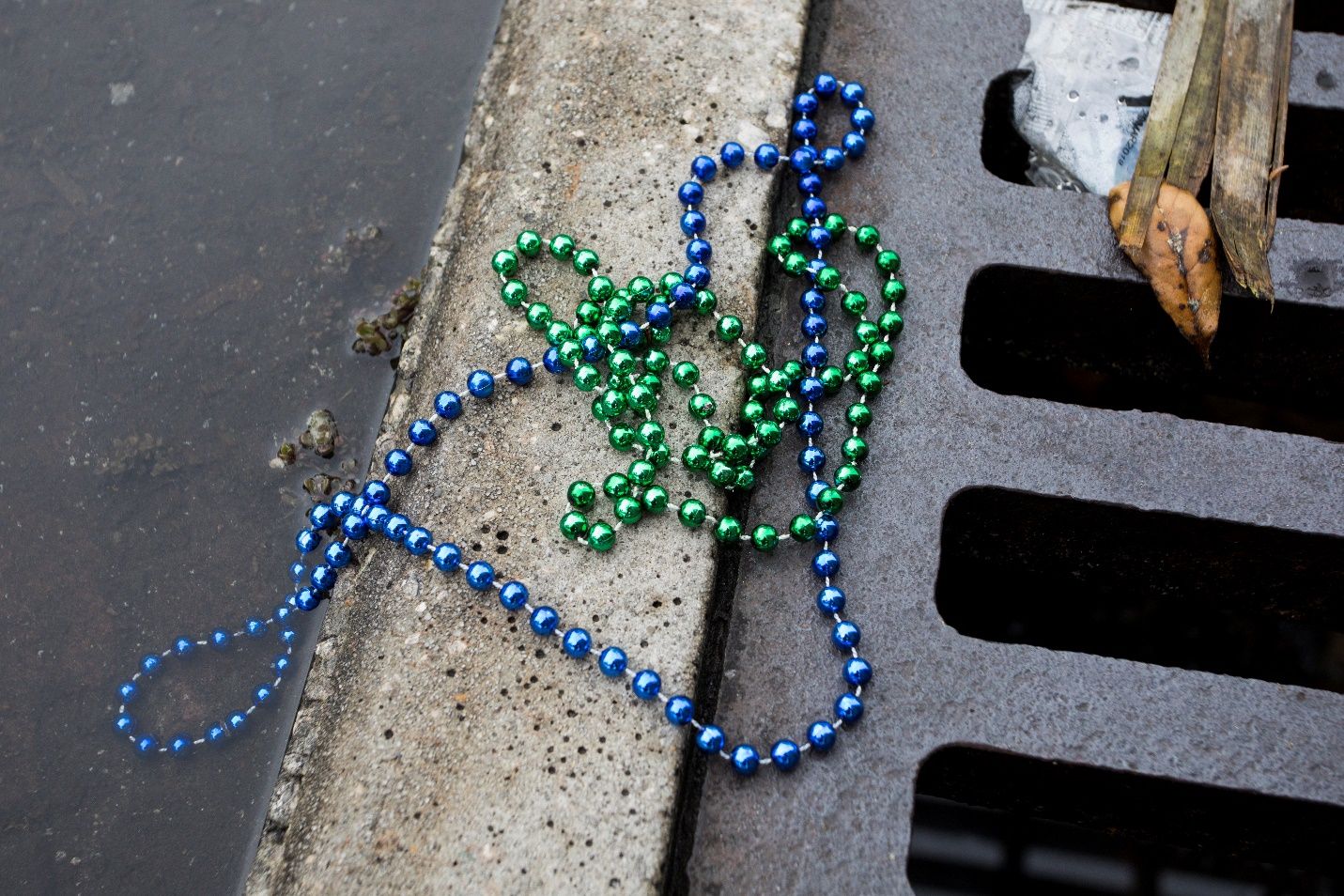
Credit: Tyler Jones, UF/ IFAS
The FDEP has extensive resources, including their recycling program contact list of individuals who can help you determine where the appropriate recycling center near you is located.
Summary
This publication serves as a resource for the public to understand the various factors and land management strategies to consider regarding pollutants mobilized by stormwater runoff. The 4 “Rights” of fertilizer management and recommendations surrounding yard waste serve as effective ways to maintain and tend to lawns and gardens while reducing the stormwater footprint of the homeowner. Secondary pollutants like soaps/detergents and automobile fluids can be addressed by using more environmentally safe products like phosphate-free soap/detergent as well as general vehicle upkeep and proper disposal of automobile fluids. Microplastics are the newest addition to the list of monitored contaminants in the environment, and they are deemed an emerging contaminant of concern. FDEP resources for the proper channels of disposal of microplastics, oil, and other contaminants are linked within this publication to connect readers to these services and options.
Resources
UF/IFAS Garden Solutions on Rain Gardens: https://gardeningsolutions.ifas.ufl.edu/design/types-of-gardens/rain-gardens.html
UF/IFAS Analytical Services Laboratories (ANSERV Labs) for Soil Testing: https://soilslab.ifas.ufl.edu/
EDIS Publication #LH014 with Fertilizer Information: https://edis.ifas.ufl.edu/publication/LH014
Florida Department of Environmental Protection (FDEP) for Oil Collection Search: https://fldeploc.dep.state.fl.us/www_rcra/Reports/puocc_query.asp
Florida Department of Environmental Protection (FDEP) for Recycling Program List: https://floridadep.gov/waste/waste-reduction/content/recycling-program-contact-list
References
Heil, C. A., and A. Muni-Morgan. 2021. “Florida’s Harmful Algal Bloom (HAB) Problem: Escalating Risks to Human, Environmental and Economic Health with Climate Change.” Frontiers in Ecology and Evolution. 9: 299. https://doi.org/10.3389/fevo.2021.646080
Jani, J., Y-Y. Yang, M. G. Lusk, and G. S. Toor. 2020. “Composition of Nitrogen in Urban Residential Stormwater Runoff: Concentrations, Loads, and Source Characterization of Nitrate and Organic Nitrogen.” PLoS ONE. 15(2): e0229715. https://doi.org/10.1371/journal.pone.0229715
Krimsky, L. S., M. G. Lusk, H. Abeels, and L. Seals. 2021. “Sources and Concentrations of Nutrients in Surface Runoff from Waterfront Homes with Different Landscape Practices.” Science of The Total Environment. 750: 142320. https://doi.org/10.1016/j.scitotenv.2020.142320
Lusk, M. G., and D. Rainey. 2021. “Best Management Practices for Irrigating Lawns and Urban Green Spaces with Reclaimed Water: SL491/SS704, 12/2021.” EDIS 2021. (6). https://doi.org/10.32473/edis-ss704-2021
Lusk, M. G., G. S. Toor, and P. W. Inglett. 2020. “Organic Nitrogen in Residential Stormwater Runoff: Implications for Stormwater Management in Urban Watersheds.” Science of The Total Environment. 707: 135962. https://doi.org/10.1016/j.scitotenv.2019.135962
Toor, G. S., and M. Lusk. 2011. “Reclaimed Water Use in the Landscape: What’s in Reclaimed Water and Where Does It Go?: SL337/SS542, 1/2011.” EDIS 2011. 2(2). https://doi.org/10.32473/edis-ss542-2011
Yang, Y-Y., and M. G. Lusk. 2018. "Nutrients in Urban Stormwater Runoff: Current State of the Science and Potential Mitigation Options." Current Pollution Reports. 4(2): 112-127. https://doi.org/10.1007/s40726-018-0087-7